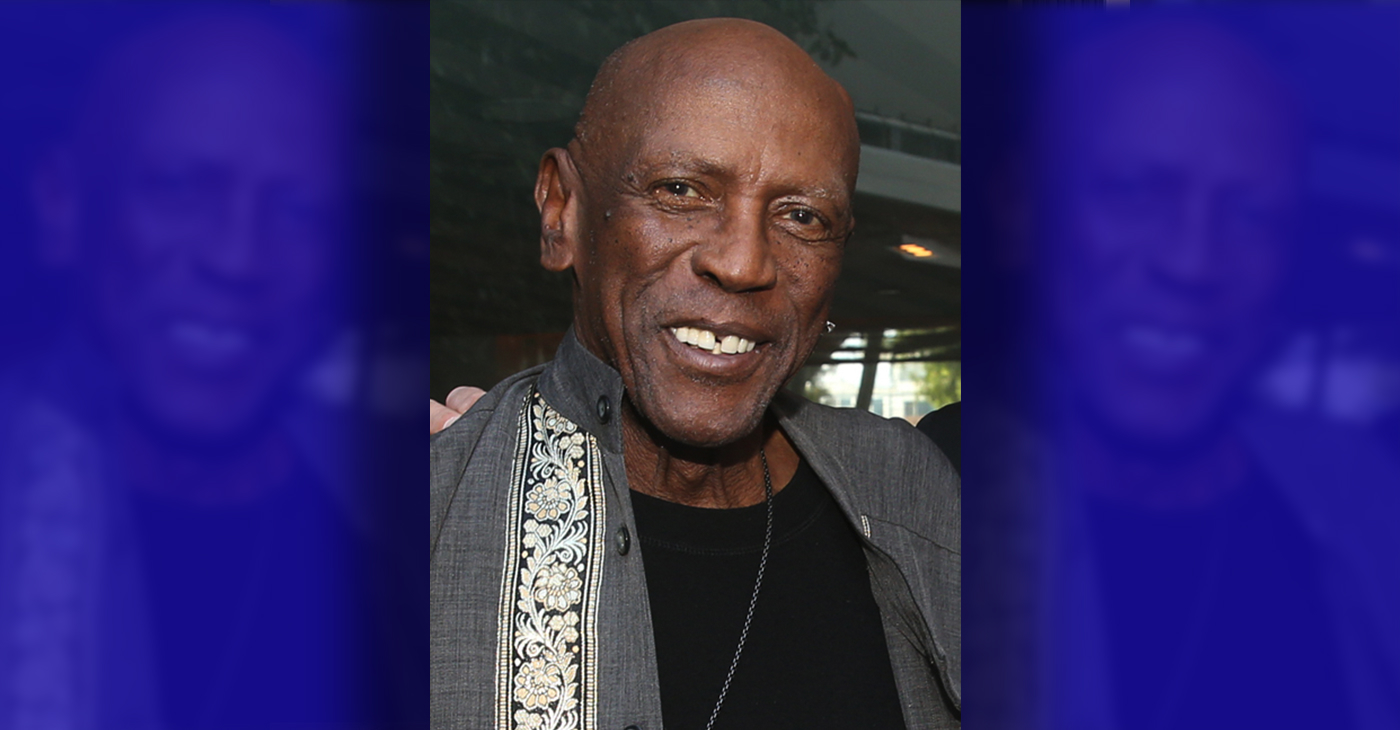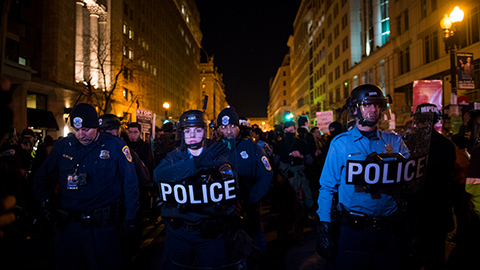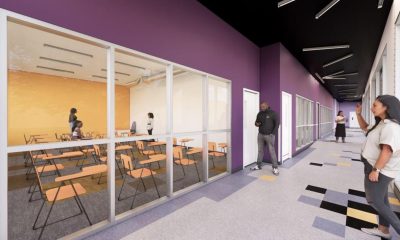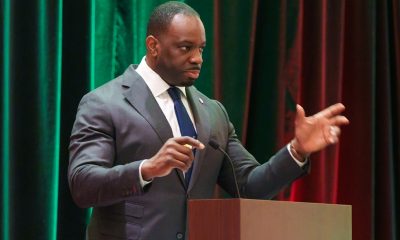#NNPA BlackPress
OPINION: Why High School Students Don’t Need the SAT Anymore
NNPA NEWSWIRE — Students this year and in the short term will be well served to keep asking questions like: “Is the investment of time and/or money to prepare for this test worth it? Is it safe and useful to take the test? And, does submitting my scores increase the likelihood that I’ll help my application or increase scholarship opportunities?
The post OPINION: Why High School Students Don’t Need the SAT Anymore first appeared on BlackPressUSA.

By Akil Bello and Harry Feder | The AFRO
College admissions is undergoing a sea change. The pandemic accelerated the already fast-moving trend of colleges reconsidering the value of SAT and ACT scores in the admission process. Many colleges have stopped considering test scores at all (test blind/free) or have allowed students to decide whether they want to include test scores as part of their applications (test-optional).
While the change in testing policy seems new to some, this movement is more than 50 years old. Almost half of all bachelor degree granting colleges had adopted test-optional or free policies before the pandemic.
Spurred by the difficulty of access to testing due to COVID but also prompted — and certainly sustained by — research on the minimal value and detrimental impact of standardized tests, more than 700 colleges have adopted a test-optional or test-free policy since 2020.
Currently, more than 1,800 colleges (roughly 80 percent of bachelor’s degree-granting colleges) have test-optional or test-free policies for those applying in 2023. These colleges range from Hampton University to CalTech to Michigan State University.
New testing policies — combined with changing demographics and the impacts of the pandemic — have changed the normal calculus of college admissions.
Some colleges have seen significantly more applications, some haven’t. Some families and students feel less certain about the advantage that a high test score provides, some are thankful that they don’t have to worry about testing. Some test prep businesses are worried about fading clientele, some are grateful to see the end of overtesting and test misuse. Some college counselors are happy they can recommend their strong students but poor test takers to colleges that might have rejected them because of a lower test score, some bemoan the loss of a potential advantage for the students they serve that test above their in-school performance.
Change brings uncertainty. Change will benefit some and disadvantage others. In this case, those who have historically benefited from testing have been wealthy White males with college-educated parents, and these changing policies threaten that advantage. For those traditionally disadvantaged by testing, minimizing the role of tests in admissions gives a sense of relief.
“There was a misconception that the number you get determines where you’d go to college,” said Star-Angel Oppong, a senior at Freedom High School in Virginia, who is currently applying to colleges. “The test instilled a lot of fear in me that I would not be successful without doing well on it.”
Oppong says some adults in her life, both intentionally and accidentally, conveyed that a student who “didn’t do well on the test, they might as well not go to college at all.”
Test optional has changed that.
The widespread adoption of these policies has created more opportunity. Students who might have been deterred from applying to certain schools simply because of scores below the published averages of that school are now applying without worrying about scores.
Amily Sylla, a first-year student at Virginia Commonwealth University, said, “It was a relief to not have to take a test and to not have the test be the reason why you didn’t get into college.” Having seen the challenges her sister faced the previous year preparing for and taking the SAT, Ms. Sylla was happy to forgo the preparation and testing process and spend her time focusing on more important things.
The smoother pathway created can be seen in data from Common App, the organization that runs a popular application by the same name used by over 900 colleges. Common App members have seen an increase in applications of more than 20 percent since the 2019-2020 application season, with the greatest increase coming from underrepresented students.
Even more dramatic than the growth in applications is the drop in scores submitted. In 2022, only 5 percent of Common App member schools required SAT or ACT tests to be submitted, and only 48 percent of applicants submitted scores.
But while these new policies decrease barriers for many, change can increase uncertainty. Some students and their supporters feel more uncertain about being able to predict the outcome of the admission process.
This nervousness is especially pronounced among those who have long relied on presenting test scores as the “key” to admissions and scholarships. Test makers, test prep companies, and independent college counselors have contributed to the anxiety by stoking fears, despite the assurances of colleges, that not testing creates a disadvantage in either admissions or access to scholarships, even at colleges that are test optional.
According to Ericka M. Jackson, Senior Director of Undergraduate Admissions for Wayne State University, “Many students and parents didn’t trust that they would really get a fair evaluation if they didn’t submit a test score. As college admissions offices, we spent a lot of time during that first test-optional admissions cycle explaining what test optional means at our institution and reassuring students, counselors, and parents that students would not be disadvantaged if they applied test optional.”
Since 2020, test publishers College Board and ACT have become particularly aggressive about marketing their tests as the key to “standing out” in the application process, suggesting that taking the test is intrinsic to securing admissions and “merit” scholarships.
But this narrative is misleading, if not outright false.
Candice Mackey, a college counselor at Los Angeles Center for Enriched Studies, said that “although all Cal-States and UCs are test-free, my students and families are ‘programmed’ for testing. It’s actually a little difficult at times to convince them otherwise that test-optional means optional.”
Making matters worse is the national media’s focus on highly rejective colleges, which make up less than 4 percent of colleges. News reports and prep company advertisements hyper-focus on scores as the reason for admission or rejection, even though these institutions almost always review applications holistically, considering many factors beyond test scores. This causes families to put undue misplaced pressure on testing.
Even in California, where public universities will not look at test scores even if submitted, the legacy of having required scores for 50 years casts a shadow on the current process. Mackey notes that “there is a lot of re-educating, explaining, and reframing what test-optional means and how testing factors into admissions.”
The confusion about how these policies play out in practice is evident in the lived experience of applicants. Wendy Jefferies, a knowledgeable graduate admissions coach, and her daughter, now a first year at Indiana University, still struggled through what was essentially two parallel admissions processes, one with scores and one without.
Jefferies expressed the uncertainty that many families face. “We didn’t know what was good or bad as a test score,” she said.
Jefferies and her daughter, who had a 27 ACT score (better than almost 90 percent of test takers nationally) and a 3.5 GPA, decided to apply with testing to Historically Black Colleges and Universities (HBCUs) and without to Predominantly White Institutions (PWIs).
This strategy was largely informed by popular narratives that suggested that scores would provide access to scholarships at HBCUs in a way they would not at PWIs. After falling short of her target ACT score twice, Jefferies and her daughter decided not to spend any more time or energy on testing. Here’s how her student did:
Colleges are not only having to deal with the difficulty of educating a public used to submitting scores, but they are often having to adjust their internal policies as their applicant pools shift from 100 percent of students submitting scores to less than half doing so.
Jackson says several adjustments were made in their policy between the first and second test optional cycles based on feedback from applicants and counselors, saying her institution was “pleased and knew that the decision we made, along with hundreds of other institutions, was in the best interest of students and removed a significant barrier to higher education, which was the ability to test. However, we quickly discovered that offering a test-optional pathway wasn’t enough, at least not for the students we served (many of whom attended under-resourced schools) and who were physically separated from the support they used to have in school because they were all learning remotely.”
The return to school has been a boon for many high school students as they are reconnected with the place-based resources that had been more difficult to access during remote learning. But the variation in policies at colleges poses a challenge to even the best-resourced college counseling office.
“It is understandable that students (and parents) were confused by so many institutions with so many different test-optional policies,” Jackson said. Some were test-optional, others were test free or test-flexible.”
Seniors applying this year and next will need to keep monitoring college websites and fairtest.org to track evolving college policies. But applicants will also need to take colleges at their word about what is important in the process. Colleges are responding to research, the current environment, and students’ needs and are updating their policies as necessary. This means there may be more tweaks in the coming years. College admission is moving away from what Mackey calls an ‘institution-centered” process.
For colleges and students alike, test-optional has been a “seismic shift,” according to Jackson. And Mackey points out that “entering year three of a mostly test-optional admissions cycle, my advisement with students and families in this particular area begins with the student first and their profile, followed by the institution second leading me to believe test-optional policy and practice is much more ‘student-centered.’”
Of course, “student-centered” considerations do not relieve the pressure on applicants to meet other competitive admissions criteria for a given institution – grades, extracurriculars, and the like.
But for many qualified students, the optional policies relieve a major application barrier.
Unfortunately, until every college follows the lead of California and removes test scores from all parts of its process, students will still have to consider how and when to engage with testing and test preparation.
Students this year and in the short term will be well served to keep asking questions like: “Is the investment of time and/or money to prepare for this test worth it? Is it safe and useful to take the test? And, does submitting my scores increase the likelihood that I’ll help my application or increase scholarship opportunities?
For students like Sylla, the answer was no. She felt her strong high school performance and activities more accurately reflected who she was and who she wanted colleges to consider. Preparing for the SAT or ACT wasn’t worth her time, and not testing didn’t prevent her from getting great outcomes. Sylla says not only did she get admitted to VCU and get scholarships, but “I got a lot, actually.”
Akil Bello serves as Senior Director of Advocacy and Advancement at FairTest. He is a former test prep company CEO, an educator, and a nationally recognized authority on educational access.
Harry Feder is the Executive Director of FairTest. He taught history in New York City public schools at Beacon School and Urban Academy Laboratory High School for 22 years. Prior to that he was an attorney in private litigation practice.
The opinions on this page are those of the writers and not necessarily those of the AFRO or BlackPressUSA. Send letters to The Afro-American • 145 W. Ostend Street Ste 600, Office #536, Baltimore, MD 21230 or fax to 1-877-570-9297 or e-mail to editor@afro.com
This article originally appeared in The Afro.
The post OPINION: Why High School Students Don’t Need the SAT Anymore first appeared on BlackPressUSA.
#NNPA BlackPress
Beloved Actor and Activist Louis Cameron Gossett Jr. Dies at 87
NNPA NEWSWIRE — Louis Gossett Jr., the groundbreaking actor whose career spanned over five decades and who became the first Black actor to win an Academy Award as Best Supporting Actor for his memorable role in “An Officer and a Gentleman,” has died. Gossett, who was born on May 27, 1936, in Brooklyn, N.Y., was 87. Recognized early on for his resilience and nearly unmatched determination, Gossett arrived in Los Angeles in 1967 after a stint on Broadway.
The post Beloved Actor and Activist Louis Cameron Gossett Jr. Dies at 87 first appeared on BlackPressUSA.

By Stacy M. Brown
NNPA Newswire Senior National Correspondent
@StacyBrownMedia
Louis Gossett Jr., the groundbreaking actor whose career spanned over five decades and who became the first Black actor to win an Academy Award as Best Supporting Actor for his memorable role in “An Officer and a Gentleman,” has died. Gossett, who was born on May 27, 1936, in Brooklyn, N.Y., was 87. Recognized early on for his resilience and nearly unmatched determination, Gossett arrived in Los Angeles in 1967 after a stint on Broadway.
He sometimes spoke of being pulled over by law enforcement en route to Beverly Hills, once being handcuffed to a tree, which he remembered as a jarring introduction to the racial tensions of Hollywood. In his memoir “An Actor and a Gentleman,” Gossett recounted the ordeal, noting the challenges faced by Black artists in the industry. Despite the hurdles, Gossett’s talent shone brightly, earning him acclaim in groundbreaking productions such as “A Raisin in the Sun” alongside Sidney Poitier. His Emmy-winning portrayal of Fiddler in “Roots” solidified his status as a trailblazer, navigating a landscape fraught with racial prejudice.
According to the HistoryMakers, which interviewed him in 2005, Gossett’s journey into the limelight began during his formative years at PS 135 and Mark Twain Junior High School, where he demonstrated early leadership as the student body president. His passion for the arts blossomed when he starred in a “You Can’t Take It With You” production at Abraham Lincoln High School, catching the attention of talent scouts who propelled him onto Broadway’s stage in “Take A Giant Step.” His stellar performance earned him the prestigious Donaldson Award for Best Newcomer to Theatre in 1952. Though initially drawn to sports, Gossett’s towering 6’4” frame and athletic prowess led him to receive a basketball scholarship at New York University. Despite being drafted by the New York Knicks in 1958, Gossett pursued his love for acting, honing his craft at The Actors Studio under the tutelage of luminaries like John Sticks and Peggy Fury.
In 1961, Gossett’s talent caught the eye of Broadway directors, leading to roles in acclaimed productions such as “Raisin in the Sun” and “The Blacks,” alongside legends like James Earl Jones, Cicely Tyson, Roscoe Lee Brown, and Maya Angelou. Transitioning seamlessly to television, Gossett graced small screens with appearances in notable shows like “The Bush Baby” and “Companions in Nightmare.” Gossett’s silver screen breakthrough came with his role in “The Landlord,” paving the way for a prolific filmography that spanned over 50 movies and hundreds of television shows. From “Skin Game” to “Lackawanna Blues,” Gossett captivated audiences with his commanding presence and versatile performances.
However, his portrayal of “Fiddler” in Alex Haley’s groundbreaking miniseries “Roots” earned Gossett critical acclaim, including an Emmy Award. The HistoryMakers noted that his golden touch extended to the big screen, where his role as Sergeant Emil Foley in “An Officer and a Gentleman” earned him an Academy Award for Best Supporting Actor, making him a trailblazer in Hollywood history.
Beyond the glitz and glamour of Hollywood, Gossett was deeply committed to community activism. In 1964, he co-founded a theater group for troubled youth alongside James Earl Jones and Paul Sorvino, setting the stage for his lifelong dedication to mentoring and inspiring the next generation. Gossett’s tireless advocacy for racial equality culminated in the establishment of Eracism, a nonprofit organization dedicated to combating racism both domestically and abroad. Throughout his illustrious career, Gossett remained a beacon of strength and resilience, using his platform to uplift marginalized voices and champion social change. Gossett is survived by his children, Satie and Sharron.
The post Beloved Actor and Activist Louis Cameron Gossett Jr. Dies at 87 first appeared on BlackPressUSA.
#NNPA BlackPress
COMMENTARY: D.C. Crime Bill Fails to Address Root Causes of Violence and Incarceration
WASHINGTON INFORMER — The D.C. crime bill and so many others like it are reminiscent of the ‘94 crime bill, which produced new and harsher criminal sentences, helped deploy thousands of police and surveilling methods in Black and brown communities, and incentivized more states to build prisons through a massive infusion of federal funding. While it is not at the root of mass incarceration, it significantly accelerated it, forcing a generation of Black and brown families into a never-ending cycle of state-sanctioned violence and incarceration.
The post COMMENTARY: D.C. Crime Bill Fails to Address Root Causes of Violence and Incarceration first appeared on BlackPressUSA.

By Kaili Moss and Jillian Burford | Washington Informer
Mayor Bowser has signed the “Secure DC” omnibus bill passed by the D.C. Council last month. But we already know that this bill will be disastrous for all of D.C., especially for Black and brown residents.
While proponents claim that this legislation “will make D.C. residents safer and more secure,” it actually does nothing to address the root of the harm in the first place and instead maintains a cycle of violence, poverty, and broken community ties. The omnibus bill calls for increased surveillance, drug-free zones, and will expand pre-trial detention that will incarcerate people at a significantly higher rate and for an indeterminate amount of time before they are even tried. This bill will roll back decades of nationwide policy reform efforts and initiatives to keep our communities safe and whole, which is completely contradictory to what the “Secure” D.C. bill claims it will do.
What is unfolding in Washington, D.C., is part of a dangerous national trend. We have seen a resurrection of bad crime bills in several jurisdictions across the country — a phenomenon policy experts have named “zombie laws,” which are ineffective, costly, dangerous for communities of color and, most importantly, will not create public safety. Throwing more money into policing while failing to fund preventative measures does not keep us safe.
The D.C. crime bill and so many others like it are reminiscent of the ‘94 crime bill, which produced new and harsher criminal sentences, helped deploy thousands of police and surveilling methods in Black and brown communities, and incentivized more states to build prisons through a massive infusion of federal funding. While it is not at the root of mass incarceration, it significantly accelerated it, forcing a generation of Black and brown families into a never-ending cycle of state-sanctioned violence and incarceration. Thirty years later, despite spending billions each year to enforce these policies with many of these provisions remaining in effect, it has done very little to create long-term preventative solutions. Instead, it placed a permanent moving target on the backs of Black people, and the D.C. crime bill will do the same.
The bill calls for more pretrial detention. When our loved ones are held on pretrial detention, they are held on the presumption of guilt for an indeterminate amount of time before ever seeing a judge, which can destabilize people and their families. According to experts at the Malcolm Weimer Center for Social Policy at Harvard University, just one day in jail can have “devastating consequences.” On any given day, approximately 750,000 people are held in jails across the nation — a number that beats our nation’s capital population by about 100,000. Once detained, people run the risk of losing wages, jobs, housing, mental and health treatments, and time with their families. Studies show that pretrial detention of even a couple of days makes it more likely for that person to be rearrested.
The bill also endangers people by continuing a misguided and dangerous War on Drugs, which will not get drugs off the street, nor will it deter drug use and subsequent substance use disorders (SUDs). Drug policies are a matter of public health and should be treated as such. Many states such as Alabama, Iowa and Wisconsin are treating the current fentanyl crisis as “Crack 2.0,” reintroducing a litany of failed policies that have sent millions to jails and prisons instead of prioritizing harm reduction. Instead, we propose a simple solution: listen to members of the affected communities. Through the Decrim Poverty D.C. Coalition, community members, policy experts and other stakeholders formed a campaign to decriminalize drugs and propose comprehensive legislation to do so.
While there are many concerning provisions within the omnibus bill, car chases pose a direct physical threat to our community members. In July 2023, NBC4 reported that the D.C. Council approved emergency legislation that gave MPD officers the ability to engage in vehicular pursuits with so-called “limited circumstances.” Sgt. Val Barnes, the head of MPD’s carjacking task force, even expressed concern months before the decision, saying, “The department has a pretty strict no-chase policy, and obviously for an urban setting and a major metropolitan city, that’s understandable.” If our law enforcement officers themselves are operating with more concern than our elected officials, what does it say about the omnibus bill’s purported intention to keep us safe?
And what does it mean when the risk of bodily harm is posed by the pursuit itself? On Saturday, Feb. 10, an Eckington resident had a near-miss as a stolen car barreled towards her and her dog on the sidewalk with an MPD officer in pursuit. What responsibility does the city hold if this bystander was hit? What does restitution look like? Why are our elected officials pushing for MPD officers to contradict their own policies?
Just a few summers ago during the uprisings of 2020, we saw a shift in public perspectives on policing and led to legislation aimed at limiting police power after the highly-publicized murders of loved ones Breonna Taylor and George Floyd — both victims of War on Drugs policing and the powers gained from the ’94 crime bill. And yet here we are. These measures do not keep us safe and further endanger the health of our communities. Studies show that communities that focus on harm reduction and improving material conditions have a greater impact on public safety and community health. What’s missing in mainstream conversations about violent crime is the violence that stems from state institutions and structures that perpetuate racial and class inequality. The people of D.C. deserve to feel safe, and that includes feeling safe from the harms enacted by the police.
Kaili Moss is a staff attorney at Advancement Project, a national racial justice and legal organization, and Jillian Burford is a policy organizer at Harriet’s Wildest Dreams.
The post COMMENTARY: D.C. Crime Bill Fails to Address Root Causes of Violence and Incarceration first appeared on BlackPressUSA.
#NNPA BlackPress
Mayor, City Council President React to May 31 Closing of Birmingham-Southern College
THE BIRMINGHAM TIMES — “This is a tragic day for the college, our students, our employees, and our alumni, and an outcome so many have worked tirelessly to prevent,” Rev. Keith Thompson, chairman of the BSC Board of Trustees said in an announcement to alumni. “We understand the devastating impact this has on each of you, and we will now direct our efforts toward ensuring the smoothest possible transition for everyone involved.”
The post Mayor, City Council President React to May 31 Closing of Birmingham-Southern College first appeared on BlackPressUSA.

By Barnett Wright | The Birmingham Times
Birmingham-Southern College will close on May 31, after more than a century as one of the city’s most respected institutions.
“This is a tragic day for the college, our students, our employees, and our alumni, and an outcome so many have worked tirelessly to prevent,” Rev. Keith Thompson, chairman of the BSC Board of Trustees said in an announcement to alumni. “We understand the devastating impact this has on each of you, and we will now direct our efforts toward ensuring the smoothest possible transition for everyone involved.”
There are approximately 700 students enrolled at BSC this semester.
“Word of the decision to close Birmingham Southern College is disappointing and heartbreaking to all of us who recognize it as a stalwart of our community,” Birmingham Mayor Randall Woodfin said in a statement. “I’ve stood alongside members of our City Council to protect this institution and its proud legacy of shaping leaders. It’s frustrating that those values were not shared by lawmakers in Montgomery.”
Birmingham City Council President Darrell O’Quinn said news of the closing was “devastating” on multiple levels.
“This is devastating for the students, faculty members, families and everyone affiliated with this historic institution of higher learning,” he said. “It’s also profoundly distressing for the surrounding community, who will now be living in close proximity to an empty college campus. As we’ve seen with other institutions that have shuttered their doors, we will be entering a difficult chapter following this unfortunate development … We’re approaching this with resilience and a sense of hope that something positive can eventually come from this troubling chapter.”
The school first started as the merger of Southern University and Birmingham College in 1918.
The announcement comes over a year after BSC officials admitted the institution was $38 million in debt. Looking to the Alabama Legislature for help, BSC did not receive any assistance.
This past legislative session, Sen. Jabo Waggoner sponsored a bill to extend a loan to BSC. However, the bill subsequently died on the floor.
Notable BSC alumni include former New York Times editor-in-chief Howell Raines, former U.S. Sen. Howell Heflin and former Alabama Supreme Court Chief Justice Perry O. Hooper Sr.
This story will be updated.
The post Mayor, City Council President React to May 31 Closing of Birmingham-Southern College first appeared on BlackPressUSA.
-

 Activism4 weeks ago
Activism4 weeks agoOakland Post: Week of March 27 – April 2, 2024
-

 #NNPA BlackPress4 weeks ago
#NNPA BlackPress4 weeks agoCOMMENTARY: D.C. Crime Bill Fails to Address Root Causes of Violence and Incarceration
-

 #NNPA BlackPress4 weeks ago
#NNPA BlackPress4 weeks agoFrom Raids to Revelations: The Dark Turn in Sean ‘Diddy’ Combs’ Saga
-

 #NNPA BlackPress4 weeks ago
#NNPA BlackPress4 weeks agoCOMMENTARY: Lady Day and The Lights!
-

 #NNPA BlackPress4 weeks ago
#NNPA BlackPress4 weeks agoMayor, City Council President React to May 31 Closing of Birmingham-Southern College
-

 #NNPA BlackPress4 weeks ago
#NNPA BlackPress4 weeks agoBaltimore Key Bridge Catastrophe: A City’s Heartbreak and a Nation’s Alarm
-

 #NNPA BlackPress4 weeks ago
#NNPA BlackPress4 weeks agoBaltimore’s Key Bridge Struck by Ship, Collapses into Water
-

 #NNPA BlackPress4 weeks ago
#NNPA BlackPress4 weeks agoBeloved Actor and Activist Louis Cameron Gossett Jr. Dies at 87















































